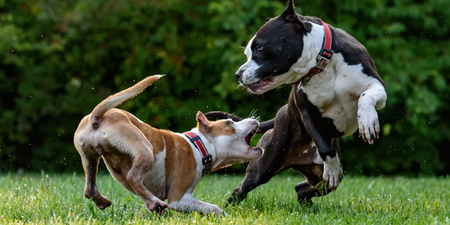Angry Growling: Growling is often a key signal of aggressive behavior. The problem? Many puppies and dogs playfully growl when they’re having fun, so it can be hard determining between playful and angry growls. Long-term observation is key here! When a dog is aggressively growling, they mean business. It will likely be stronger than usual, paired with exposed teeth and a stand-offish pose. The best way to identify aggressive growling is to be familiar with your dog’s playful growls; you’ll know the differences when you see them.
Snapping: Much like growling, it’s completely normal for dogs to playfully bite each other (and humans) during play. But dogs know exactly what they’re doing, and the only reason why they’re not drawing blood is that they know it’s playtime and they’re purposely being gentle. But even a small dog’s bite can be extremely powerful when they mean it, and if your dog starts snapping at people (or other dogs), they usually intend to bite with full force. This is a defensive behavior and you must not allow it to be normalized.
Resource Guarding: We’ve talked about resource guarding in past blog posts, but it’s important to mention in this list because it’s a dangerous behavior that needs to be treated ASAP. In a nutshell, resource guarding is when your dog defensively “guards” something that they’re possessive of, whether it’s a toy, food, or a certain area that they’ve claimed. Possessive behavior needs to be treated because dogs can resort to aggressive methods when they’re guarding. Keep an eye out for defensive stances, a raised (or tucked) tail, and flattened ears.
Fear: Most dogs aren’t inherently malicious, and they only resort to dangerous behaviors when they feel threatened. That’s why you need to be cautious around fearful dogs; they might appear to be harmless, but in reality, they could lash out at any moment. If your dog is highly skeptical and afraid of fellow humans and canines, tread lightly, because they could be dangerous when cornered. If you have a “scaredy-dog,” specialized training can help them to overcome their fears, and that’s exactly what I offer at Lupa K9 Training.

